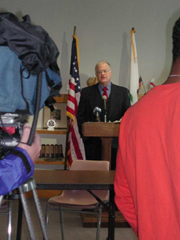|
Getting More Transit Bang for your Toll Bridge Buck
Bay Area leaders show support for funding enhanced transit in region
 |
| Greater than 2/3 of those surveyed would willingly pay an extra $1 bridge toll if it was dedicated to public transit. |
At a recent press
conference, State Senator Don Perata (D-Oakland) unveiled his vision for finding a revenue stream that will support all Bay Area transit systems, including the expansion of BART, express and feeder buses, commuter rail and new and enhanced ferry routes.
Based on the results of a recent Water Transit Authority-sponsored survey, Bay Area voters indicated that they would willingly pay an extra $1 tacked onto state bridge tolls if that money was dedicated to funding public transit. Only a fraction of the first dollar from the current $2 toll is used for public transit. Senator Perata noted, “There’s currently no light at the end of the tunnel for Bay Area commuters. We now have evidence that people recognize that paying for solutions to the gridlock crisis is sound public policy.”
Along with other modes of transit, the survey queried support for expanding the Bay Area’s ferry service. Of those surveyed, 69% were much more or somewhat more likely to favor paying an extra dollar toll for new ferry service, 63% favored spending it on more ferries on the existing routes, and 75% supported ferry service as an alternative to driving. But, a whopping 82% of those surveyed were much or somewhat more likely to back funding a comp
rehensive intermodal transit system that allowed them to conveniently switch from bus to ferry to train as needed to reach their final destination.
Voters may soon have the opportunity to show their support for a toll increase. Senator Perata will begin public hearings this year through his Select Committee on Bay Area Transportation to discuss funding options. With the help of regional transportation agencies he will schedule a series of meetings geared toward developing an expenditure plan.
 |
| California Senator Don Perata introduced his proposal to write a transportation funding expenditure plan. |
Stuart Cohen, Director of the Bay Area Transportation and Land Use Coalition, which represents over 80 environmental and community groups, noted that for less than it costs to purchase a cup of coffee each day, drivers can increase the number of alternatives to being stuck in traffic. He concluded that the price to an individual for this transit funding plan is a real bargain.
Members of Sen. Pera
ta’s working group will be tasked with recommending how to best allocate additional funding to best meet the Bay Area’s transportation needs. The plan will not “reinvent the wheel” according to
Perata, but rather research options, gather input from the public on their concerns and determine the best way to divide monies. With a well-thought proposal, Sen. Perata hopes to convince the state legislature that the time is right for taking action. If the legislature remains unconvinced that a toll increase, even one endorsed by surveyed voters, is politically wise, it is likely that this measure will then go to voters for approval in 2004.
When asked why he thinks that more money for transit will encourage recalcitrant drivers to take transit rather than choosing the convenience of their own automobile, Sen. Perata cited the three requirements that make transit an attractive option: affordability, reliability and frequency. With better funding to expand, enhance and connect services, transit operators will be enabled to assure the riding public of these three key components.
According to Senator
Perata, an increased toll is not envisioned as a deterrent to people using the bridges. In fact, the $2 bridge toll is lower than average in comparison to toll bridges nationally and internationally. However, the revenue raised would be used to s
upport alternatives, which in turn would help to relieve congestion in corridors frequently used by bridge commuters. At a time when congestion is causing our regions bridges to become parking lots, it becomes clear that viable transportation alternatives are needed.
 |
| Present and future ferry commuters hope for convenience and reliability in making transit connections. |
Ferries are one option to providing stress free, quick movement across the Bay. For a fraction of what a $1 toll increase would generate in funding, more ferries, terminals and improved bus and rail connections could be operated and constructed. Expansion of ferry services would help alleviate traffic congestion and to improve air quality, two high priority issues within the nine county Bay Area.
Connecting counties via water and encouraging people to get off highways and bridges through ferry service will be one important part of the solution to traffic congestion and air pollution. San Mateo County Supervisor Mike Nevin emphasized the viability of an expanded ferry system stating, “Water transit is not a new idea. It is how people lived and traveled before bridges and dependence on automobiles. There is a need for safer, cheaper, reliable transportation and with the ferry you get not only this, but something exciting and romantic as well.”
|